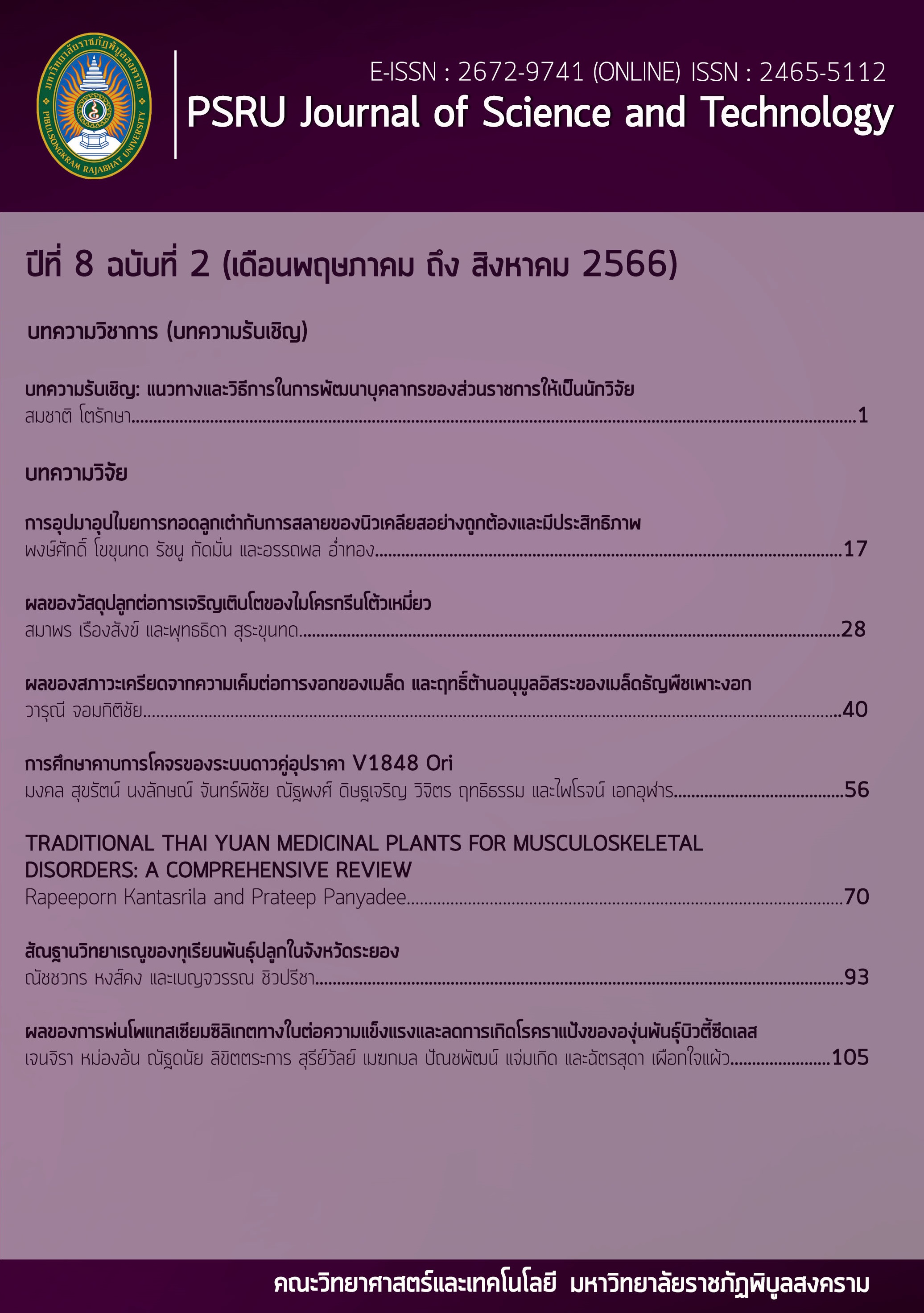EFFECTS OF POTASSIUM SILICATE FOLIAR APPLICATION ON PLANT VIGOR AND POWDERY MILDEW DISEASE REDUCTION OF GRAPEVINE CV. BEAUTY SEEDLESS
Keywords:
Silicon, Grapevine, Powdery mildew, Resistance, Plant stressAbstract
Climatic and pest factors are the major causes of yield loss of grape in Thailand. Nowadays, silicon (Si) is extensively used as a beneficial element for enhancing vigor of cereal plants. However, the role of Si in enhancing vigorous of grape is scant. The objective of this study was to evaluate the effect of potassium silicate (K2SiO3) on plant vigor and reduction of powdery mildew disease of grape. The experiment was laid out in Randomized complete block design (RCBD) with 4 replications. Four concentrations of potassium silicate (0, 1000, 2000 and 3000 mg/L/plant) were foliar applied to the grapevine cv. Beauty Seedless at full bloom-setting growth stage. Thereafter the foliar application was repeated every 10 days for 7 times. Then, growth, yield, index of berry crack and disease index of powdery mildew of leaf and berry were determined in 200 sub-samples for each treatment. The results revealed that potassium silicate at the concentration of 1000 mg/L decreased berry crack index and powdery mildew disease index in leaf and berry for 27.50, 30.65 and 34.65% respectively. The concentration of 2000 and 3000 mg/L showed the greatest decrease of berry crack index and powdery mildew disease index in leaf and berry for 92.56, 79.03 and 70.83% respectively, which were significantly higher than the concentration of 1000 mg/L. Moreover, leaf chlorophyll content and yield of grape were slightly increased by potassium silicate application. Thus, we can conclude that potassium silicate has an important role in enhancing plant tissues vigor against berry cracks and plant pathogen infection rather than promoting growth and yield of grape.
References
สถาบันวิจัยและพัฒนาพื้นที่สูง (องค์การมหาชน). (2559). องุ่นพันธุ์ Beauty Seedless. สืบค้นเมื่อ 9 ธันวาคม 2562, จาก https://web2012.hrdi.or.th/knowledge/detail.
สุรศักดิ์ นิลนนท์. (2555). เทคโนโลยีการผลิตองุ่นและการทำไวน์. กรุงเทพฯ: มหาวิทยาลัยเกษตรศาสตร์.
สุรีย์วัลย์ เมฆกมล, กาญจนา วิชิตตระกูลถาวร, และเรณู สุวรรณพรสกุล. (2559). ผลของโพแทสเซียมซิลิเกตในการควบคุมโรคราแป้งและราน้ำค้างของแตงกวาญี่ปุ่นภายใต้สภาพโรงเรือนและแปลงปลูกของเกษตรกร. วารสารเกษตร, 32(1), 51-59.
Arnon, D.I., & Stout, P.R. (1939). The essentiality of certain elements in minute quantity for plants with special reference to copper. Plant Physiol., 14, 371-375.
Bassiony, S.S., & Ibrahim, M.G. (2016). Effect of silicon foliar sprays combined with moringa leaves extract on yield and fruit quality of “flame seedless” grape (Vitis vinifera L.). J. Plant Production, Mansoura Univ. 7(10), 1127-1135.
Cherif, M., Asselin, A., & Balanger, R.R. (1994). Defense responses induced by soluble silicon in cucumber roots infected by Pythium spp. Phytopathology, 84, 236-242.
Epstein, E. (1994). The anomaly of silicon in plant biology. Proc. Natl. Acad. Sci., 91, 11-17.
Fawe, A., Abou-Zaid, M., Menzier, J.G., & Belanger, R.R. (1998). Silicon-mediated accumulation of flavonoid phytoalexins in cucumber. Biochem. Cell Biol., 88, 396-401.
Guerriero, G., Hausman, J.F., & Legay, S. (2016). Silicon and the plant extracellular matrix. Front. Plant Sci., 7, 463.
Liang, Y.C., Sun, W.C., Si, J., & Romheld, V. (2005). Effects of foliar and root applied silicon on the enhancement of induced resistance to powdery mildew in Cucumis sativus. Plant Pathol., 54, 678-685.
Ma, J.M. (2004). Role of silicon in enhancing the resistance of plants to biotic and abiotic stresses. Soil Sci. Plant Nutr., 50(1), 11-18.
Ma, J.F., & Takahashi, E. (2002). Soil, fertilizer, and plant silicon research in Japan. Amsterdam: Elsevier Science.
Marschner, H. (1995). Mineral nutrition of higher plants. (2nd Edition). London: Academic Press.
Menzies, J.G., Ehret, D.L., Glass, A.D.M., Helmer, T., Koch, C., & Seyward, F. (1991). Effects of soluble silicon on the parasitic fitness of Sphaerotheca juliginea on Cucumis sativus. Phytopathology, 81, 84-88.
Ng, L.C., Adila, Z.N., Sharul Hafiz, E.M., & Aziz, A. (2021). Foliar spray of silicon enhances resistance against Pyricularia oryzae by triggering phytoalexin responds in aerobic rice. Eur. J. Plant Pathol., 159, 673–683.
Rashad Y.M., El-Sharkawy, H.H.A., Belal, B.E.A., Abdel Razik, E.S., & Galilah, D.A. (2021). Silica nanoparticles as a probable anti-oomycete compound against downy mildew, and yield and quality enhancer in grapevines: field evaluation, molecular, physiological, ultrastructural, and toxicity investigations. Front. Plant Sci., 12, 763365. Doi: 10.3389/fpls.2021.763365.
Ramteke, S.D., Urkude, V., Parhe, S.D., & Bhagwat, S.R. (2017). Berry cracking; its causes and remedies in grapes – a review. Trends Biosci., 10(2), 549-556.
Downloads
Published
Versions
- 2024-05-29 (2)
- 2023-08-23 (1)
How to Cite
Issue
Section
License
Copyright (c) 2023 PSRU Journal of Science and Technology

This work is licensed under a Creative Commons Attribution-NonCommercial-NoDerivatives 4.0 International License.
กองบรรณาธิการขอสงวนสิทธิ์ในการปรับปรุงแก้ไขตัวอักษรและคำสะกดต่างๆ ที่ไม่ถูกต้อง และต้นฉบับที่ได้รับการตีพิมพ์ในวารสาร PSRU Journal of Science and Technology ถือเป็นกรรมสิทธิ์ของคณะวิทยาศาสตร์และเทคโนโลยี มหาวิทยาลัยราชภัฏพิบูลสงคราม และ
ผลการพิจารณาคัดเลือกบทความตีพิมพ์ในวารสารให้ถือมติของกองบรรณาธิการเป็นที่สิ้นสุด







